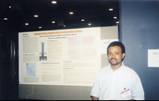Modeling Groundwater Denitrification by Ferrous Iron with PHREEQC

Tedros Tesfay has a B.S. in Chemistry from the University of Asmara, Eritrea, and a M.S. in Radiogenic Isotope Geochemistry from University of New Mexico, Albuquerque, New Mexico. He is currently pursuing his Ph.D. in Geology at the University of North Dakota with a research specialization of hydrogeology.
tedros@und.nodak.edu
Fellow: Tedros Tesfay
Adviser: Scott Korom
Department of Geology and Geological Engineering
Modeling Groundwater Denitrification by Ferrous Iron with PHREEQC
Problem Description
Nitrate is one of the most common groundwater contaminants. Denitrification converts nitrate irreversibly into harmless nitrogen gas. It is a natural process that requires an anaerobic environment, denitrifying bacteria, and sufficient and reactive electron donating species. Numerous researchers show that the availability of electron donors within aquifer sediments limits the denitrification potential of aquifers. The three common electron donors for denitrification are organic carbon, sulfide (usually as pyrite), and ferrous iron. Reduced manganese may also contribute to denitrification, but it has never been shown to be a significant electron donor for denitrification in an aquifer. Our denitrification research team show organic carbon and sulfide are active electron donors for denitrification in North Dakota and Minnesota. We also believe ferrous iron is an active electron donor; however, the geochemical evidence for ferrous iron is more difficult to demonstrate and requires comprehensive knowledge of the hydrogeochemistry of the research sites.
Scope and Objectives
Denitrification in aquifers involves numerous hydrogeochemical processes with both the water and sediment phases. Theses include dilution, ion exchange, dissolution, precipitation, and oxidation-reduction reactions. Knowledge of the above reactions will enable us to decipher the denitrification capacity of aquifers, particularly when ferrous iron minerals are involved. Therefore, our objective is to use PHREEQC in order to gain a more comprehensive understanding of the hydrogeochemical environment that governs denitrification by ferrous iron and associated aquifer reactions. This research complements the previous works by investigating the role of Fe(II) in the regional aquifer denitrification processes. Geochemical modeling, PHREEQC, is employed to gain insight into the in situ denitrification processes that take place via all major electron donors.
Summary of Research Results
A better way to estimate groundwater denitrification reaction is to compute the mass balance of the redox sensitive species. The University of North Dakota (UND) denitrification team installed mesocosms (ISMs) to understand the fate of a contaminant nitrate in the actual field conditions. Many studies, including the works of the UND denitrification team, have shown evidently, using the mass balance method of estimation, 17 the significant role of sulfides (dominantly pyrite) and organic carbon in the denitrification processes of aquifers. However, the role of Fe(II) has largely been overlooked in the regional studies mainly because of two reasons: 1) the geochemical evidence for ferrous iron is more difficult to decipher due to the precipitation of Fe(III)- oxyhydroxides from the aqueous solution. 2) in the event when denitrification by both Fe(II) and organic carbon gave rise to precipitating reaction products, the role of Fe(II) is deceivably masked by that of the organic carbon. Therefore, two important measures were taken to tackle the problems.
First the abundance of Fe(II) and the minerals that host it were determined using multiple complementary analytical techniques: wet chemical extractions, x-ray diffraction and Mössbauer spectroscopy. The results of these analyses confirmed that the sites, where pyrite and organic carbon did not seem to be dominant, are found to be relatively rich in potential ferrous iron minerals. Then the use of a geochemical modeling resolved the intricacy between the two precipitating denitrification reaction products by figuring out the maximum amount of inorganic carbon that could be produced in the process. First, PHREEQC simulated the amount of inorganic carbon precipitated out from solution indirectly through the co-precipitating Ca 2+ and Mg 2+ that were released into solution by cation exchange reactions. In some of the sites, Ca 2+ and Mg 2+ mmoles/L were also decreased in solution. Therefore, computing the mass balance of Ca 2+ and Mg 2+ provided the maximum fraction of these cations lost from both the solid phase and solution. If all these cations were assumed to be co-precipitated together with the inorganic carbon, which is not likely, it provides the upper limit for the inorganic carbon that can possibly produced in the N-ISMs. By process of elimination the net nitrate lost due to denitrification but not accounted for by reactions with pyrite and organic carbon was attributed to Fe(II) and verified through the forward geochemical modeling.
During the verification work emphasis was given to the modeled and measured cations, anions and pH values. Cations of the Robinson N-ISM matches well (Fig. 1a). As expected Na+, the cation associated with the tracer Br-, shows some deviations. Measured and modeled anions, except some minor deviation in Robinson (Fig. 1b), are in agreement. Recalling the challenge of imitating the natural geochemical environment on one side and practicality of the modeling work on the other side, the above observations are satisfactory.
Conclusion
All aqueous analytical data, mineralogy and chemistry of sediments and geochemical modeling works are evidently showing the proportional role of the common electron donors (Fig. 2) and Fe(II)-supported denitrification has a significant role as a natural remediation process (Table 1). Validation of the modeling work by comparing output files with the target solutions of different time steps, chosen previously to verify the work, demonstrate that dilution, CEC and reversible reactions were responsible for the geochemical evolution observed in the C-ISM. Whereas for the nitrate chamber, in addition to dilution, CEC, and reversible reactions, denitrification reaction that involves CH2O, FeS2 and Fe(II) were the major processes that evolved the geochemical environment of the N-ISMs. Moreover, close observation of the hydrochemical data of the ISMs also demonstrate that denitrification rate was higher for those sites with high concentration of electron donors and vice versa.

Scott F. Korom
Geology & Geological Engineering
UND


